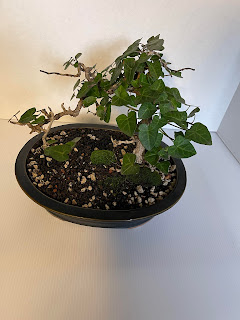Hi there to everyone.
Don't let the snow balls hit you in the well now, you know where and start monitoring the weather in your area of the world.
So here we are in the month of October and it is getting close to getting into colder weather and so I personally have brought in all of my tropical bonsai and plants even last month in September. Although I wish I had a green house I do not, and it is not that I could not afford one. It is simply more of the plain fact I do not have the room where I live to set one into place and have it.
So as a bonsai artist I have a very limited amount of topicals and I keep the collection small so that I can keep them in my home inside during the winter time. However all the rest of my trees stay in there original positions in the garden all winter. Now the only time that may differ is if I know in advance that we are in for some really severe and bad weather. Let's say for instance a really sudden cold snap or high winds and or ice sleet snow and the like then of course I do take the necessary precautions to protect my plants and trees.
Let's first talk about locations and how you may display your trees. Everyone has a different kind of a garden and a different amount of room and such for display. So the type of precautions you may take are a matter of choice and what kind garden you have and of course the effort you wish to be involved in and the room you have to move plants and the time constraints and so on.
You may be in the position to put your plants in a protected are like a shed a garage or shop what ever and of course depending on how many you have and need to move to safety. Sadly to say I'm not blessed with that option so it is what it is and I make do with what I have.
I for one have never personally done or do what the norm suggests I use my own common sense and do what simply works for me. All right you say well what is that? Well so here goes my explanation of what I do to winterize or protect my trees if I know bad or harsh conditions are on the way. First of all I will move my tress down from any display stands to the ground and then if possible huddle them as close to together as possible and if at all possible up against a structure if possible. Also the location of your display garden matters. Is it east, or west, or north, or south, light and or winds and or other elements that might affect your trees.
My garden is rather large in respect to the lay out. I have one side that is east and west light so I get the morning light and sun on one side of my garden from about early sunrise till around 1:00 pm and then that side becomes full shade for the rest of the day and is a prefect place for a lot of my deciduous or more fragile trees. The other side is full sun from around 1:00 pm until sunset so it does get hot and needs to be monitored a little more often especially if it is a really hot summer like we had this year with temps rising into the triple digits and believe me it was hot.
On the other hand it is the perfect place for all of my confers, and I have a lot of them. As most of you should already know confers do like full sun and can tolerate it fairly well and still not harm the trees.
Now winter is a different ball game. Like I stated it depends on the conditions. Now let me back up for just a moment and explain bonsai display. For the most part everyone I know displays there tress on some kind of a wooden structure of sorts. Individual stands for instance or long displays where several trees are displayed on the bench and or structure.
Well it may surprise you to know I do not display that way no indeed all of my trees are displayed on Cinderblock built up stands if you will. I try to keep most tress at different heights as to make the viewer not get totally bored while viewing and looking at my bonsai. Now for the reason I use cinder block for displays is that it is heavy and not going any place once set into position and the main reason is that wood rots, cinder block does not and I can tear down and move the display easily any time I so desire.
Here in the Northwest mother nature is the garden hose all winter and so I do not ever need to water any trees out side. Yes I know there are woods that are treated and so forth but trust me they still do rot and so I simply made the decision a long time ago not to ever build show stands or displays of wood. But that is your choice.
Now if for any reason I do need to bring the plants to the ground for protection then the cinder block displays also provide a very nice wind break and I can simply move 90 percent of my tress to the ground in a couple of hours and then they are well protected from high winds and as for ice and snow well let it fall as it only acts as a insulator like I stated earlier.
Now I now that a lot of books and articles state to use mulch and or hay and other various products to help protect and to also some what insulate the trees. I know a lady that uses old blankets I do not knock it if it works for her then it does and so be it I would not take a hammer and try to fix what is not broke. She swears by it.
I have never done that and never will unless were way below zero for many days and it simply so far in my life time in this area never got that cold the worst may have been 19 degrees and trust me confers can handle that kind of temps. One thing I will add here is that be prepared ahead of time do not wait till the last minute to make adjustments to your garden. I for one simply do not baby any of my bonsai they either make it or they don't. Simply put things do die and especially trees can go at any time no mater what you might do or think.
I will add that I personally have never lost a tree to cold weather but I did loose a couple this year do to the sever heat and it was my own fault for not moving the particular tree to a shady location in the garden. Being lazy and or not fully attentive cost me two trees that were very favorites of mine and not to mention they were very old and had been in training for many years. Oh and I lied I lost an azalea one year because it was in a cheap pot and that pot cracked and well you can guess the rest.
Also I might add it may continue with unpredictable weather conditions around the globe and I think we all know why. If you don't well then look up global warming.
Oh well you gain some and you loose some that is the nature of this hobby and anyone who tells you different is either a braggart or a liar. Trees do die and that is just the way of it. So if you can not handle that then do not create bonsai or buy them. I could rattle on and on for days about the various ways to protect plants and or bonsai in the winter time but I will leave you to do your very own assessment of how you wish to go about it in your particular garden and I will continue do mine as I always have simply because it works for me..
In closing I will state this fact to you. Be diligent and monitor the daily and nightly weather in your own area and be aware that topicals will not survive at temps below 42 degrees. So get them in a heated green house or bring them in doors to a well lighted area either with naturel light preferred or if not that for what ever reason then use plant grow lights.
If you have a cell phone or a tablet or a computer it is very easy to check in your area and know what the weather is going to be at any given time so no excuses if you do not check and loose plants. Also an important note here if the temp drops to the point that your trees are frozen solid in the pots then you can have a problem. Because you can not get water to the roots in that condition so the rule of thumb here is to have watered very good before the freeze. Need I say that once again water before the freeze a few hours in advance if at all possible.
The plants and or trees can then release moisture as they need it to the roots. Expect to loose your trees for sure if you did not carry out this task before a hard freeze. I have had winters here where the posts were frozen solid and like concrete for many days and still my trees and plants survived just fine when I watered before the freeze. Now I'm not talking just for say a one night freeze here I'm talking when it stays that way for many days.
By the way here is what it looked like in part of my garden the very first day an hour after it started snowing.
A few hours later I realized that it was not going to be a short duration and was only going to get worse so I moved all the trees to the ground in front of there stands.
Trust me this is only a few I have nearly three hundred eighteen bonsai so it took about three hours to move them all and I was needless to say a tired man when done but it was necessary. So good luck to you where ever in the world you are and have a happy holidays on the horizon. Be prepared is the word of the day. Please if you have not read the article I wrote in 2019 about winterization it has suggestions that are not in this article so I suggest you read it also.
By: Harold Yearout ©Copyright 2021 Harold Yearout All Rights Reserved for more information feel free to contact me: h.yearout@gmail.com







